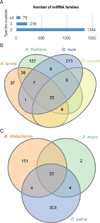The evolution of microRNAs in plants
- PMID: 27886593
- PMCID: PMC5342909
- DOI: 10.1016/j.pbi.2016.11.006
The evolution of microRNAs in plants
Abstract
MicroRNAs (miRNAs) are a central player in post-transcriptional regulation of gene expression and are involved in numerous biological processes in eukaryotes. Knowledge of the origins and divergence of miRNAs paves the way for a better understanding of the complexity of the regulatory networks that they participate in. The biogenesis, degradation, and regulatory activities of miRNAs are relatively better understood, but the evolutionary history of miRNAs still needs more exploration. Inverted duplication of target genes, random hairpin sequences and small transposable elements constitute three main models that explain the origination of miRNA genes (MIR). Both inter-species and intra-species divergence of miRNAs exhibits functional adaptation and adaptation to changing environments in evolution. Here we summarize recent progress in studies on the evolution of MIR and related genes.
Copyright © 2016 Elsevier Ltd. All rights reserved.
Figures


Similar articles
-
Comparison of miRNA Evolution and Function in Plants and Animals.Microrna. 2018;7(1):4-10. doi: 10.2174/2211536607666180126163031. Microrna. 2018. PMID: 29372676 Review.
-
De novo origination of MIRNAs through generation of short inverted repeats in target genes.RNA Biol. 2019 Jun;16(6):846-859. doi: 10.1080/15476286.2019.1593744. Epub 2019 Mar 30. RNA Biol. 2019. PMID: 30870071 Free PMC article.
-
Origins and evolution of microRNA genes in plant species.Genome Biol Evol. 2012;4(3):230-9. doi: 10.1093/gbe/evs002. Epub 2012 Jan 4. Genome Biol Evol. 2012. PMID: 22223755 Free PMC article.
-
Dual coding of siRNAs and miRNAs by plant transposable elements.RNA. 2008 May;14(5):814-21. doi: 10.1261/rna.916708. Epub 2008 Mar 26. RNA. 2008. PMID: 18367716 Free PMC article.
-
Plant microRNAs and development.Int J Dev Biol. 2005;49(5-6):733-44. doi: 10.1387/ijdb.052015sj. Int J Dev Biol. 2005. PMID: 16096978 Review.
Cited by
-
Mechanisms of microRNA-mediated gene regulation in unicellular model alga Chlamydomonas reinhardtii.Biotechnol Biofuels. 2018 Sep 8;11:244. doi: 10.1186/s13068-018-1249-y. eCollection 2018. Biotechnol Biofuels. 2018. PMID: 30202439 Free PMC article. Review.
-
Genome-wide identification of MITE-derived microRNAs and their targets in bread wheat.BMC Genomics. 2022 Feb 22;23(1):154. doi: 10.1186/s12864-022-08364-4. BMC Genomics. 2022. PMID: 35193500 Free PMC article.
-
Expression Pattern of FT/TFL1 and miR156-Targeted SPL Genes Associated with Developmental Stages in Dendrobium catenatum.Int J Mol Sci. 2019 Jun 3;20(11):2725. doi: 10.3390/ijms20112725. Int J Mol Sci. 2019. PMID: 31163611 Free PMC article.
-
The Role of Non-Coding RNAs in Cytoplasmic Male Sterility in Flowering Plants.Int J Mol Sci. 2017 Nov 16;18(11):2429. doi: 10.3390/ijms18112429. Int J Mol Sci. 2017. PMID: 29144434 Free PMC article. Review.
-
Miniature Inverted-repeat Transposable Elements Drive Rapid MicroRNA Diversification in Angiosperms.Mol Biol Evol. 2022 Nov 3;39(11):msac224. doi: 10.1093/molbev/msac224. Mol Biol Evol. 2022. PMID: 36223453 Free PMC article.
References
-
- Martínez de Alba AE, Elvira-Matelot E, Vaucheret H. Gene silencing in plants: a diversity of pathways. Biochim Biophys Acta. 2013;1829:1300–1308. - PubMed
-
- Ameres SL, Zamore PD. Diversifying microRNA sequence and function. Nat Rev Mol Cell Biol. 2013;14:475–488. - PubMed
-
- Sunkar R, Li Y-F, Jagadeeswaran G. Functions of microRNAs in plant stress responses. Trends Plant Sci. 2012;17:196–203. - PubMed
-
-
Chávez Montes RA, de Fátima Rosas-Cárdenas F, De Paoli E, Accerbi M, Rymarquis LA, Mahalingam G, Marsch-Martínez N, Meyers BC, Green PJ, de Folter S. Sample sequencing of vascular plants demonstrates widespread conservation and divergence of microRNAs. Nat Commun. 2014;5:3722. ** In this study, the authors sequenced small RNAs from algae and from representative species across vascular plants, identified miRNAs, and characterized the 5 main features of these miRNAs. This study provided an overview of miRNAs across the plant kingdom for the first time and set the foundation for future studies on miRNA evolution.
-
Publication types
MeSH terms
Substances
Grants and funding
LinkOut - more resources
Full Text Sources
Other Literature Sources

